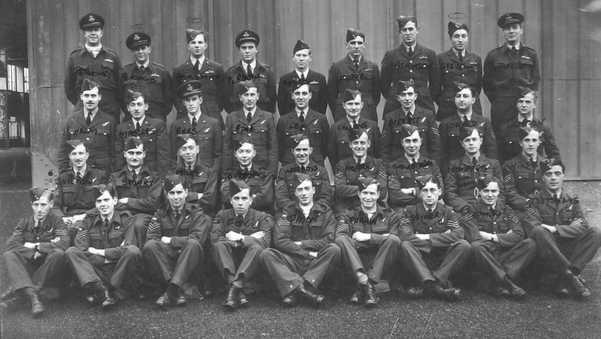
Airmen associated with the crew of AW288
Every airman listed on this page was either in training with the aircrew of AW288 or flew with the same squadron. We are endeavouring to add those that flew with Frank Day prior to the arrival of the others and in his time at 248 squadron.
5 Operational Training Unit (Coastal)
These are the names of the airmen in the group photo below taken at 5 OTU. Their ranks listed here are those they held then. We don't know when it was taken but we know it was between 14th October 1941 and the 1st December. It's unlikely the photo was taken early on the course as the pilots had to be familiarised with the plane before the crews were formed. Each crew is standing one behind the other with the pilots in the top row, Observers the 2nd row and Wireless Operator/Air Gunners in the lower two rows. While crews were formed and trained at OTU they were often broken up on or after arrival at squadrons.
We're not sure that this represents the whole intake of a single course or even if everyone photographed was on the same course although it seems very likely. We believe Cliff Thompson was on the same course at 5 OTU and he also went to 86 squadron but it looks as though he and his crew were unavailable at the time the picture was taken. We would be very grateful to receive further information regarding any of the airmen featured on this page.
The course photograph taken at RAF Chivenor, exact date unknown

Pilots (top row)
Pilot Officers: Richard John Twomey RAAF, Reginald William Hopkins RAAF1, Alexander George Murray-Smith5, James Abram RAFVR, Sergeants; Grey, Allan Hurrell4, John Campbell Atkinson, Roy Walter George Stephens2 and Pilot Officer Malcolm Stuart Davidson6.
Observers (2nd row)
Sergeant Laurence Helme RAFVR, Pilot Officer Raphael Masters1, Pilot Officer George Lawrence Eyles5, Sergeants Hugh Gregory Edge RAFVR, Lee, Stanley Alan Collins4, Everett3, Cyril Tofield2 and Ralph Lennon6.
Wireless Operator/Air Gunners (3rd row)
Sergeants: John Leslie ("Johnny") Chilton7, Robert Archibald Smart1, Les Miles5, Norman Arthur Burroughs RAFVR, Warboys, Stanley James Hoare4, John Orford Twelvetrees, Leslie Frank Humphrys2 and Winfield6.
Wireless Operator/Air Gunners (4th row)
Sergeants: Charles Edwin "Ted" Lyon, Gerald Boyle1, George Frederick Parkes5, Frederick George Fox RAFVR, Robert McIlwraith Paton4, Frederick William Parkin4, Charles Richard Taylor, Jack Hayhurst2 and George Tsitselis6.
Notes
- This crew was killed while still at 5 OTU. Their aircraft, Beaufort N1044, crashed into high ground when descending through cloud at Exford, Devon, at 2207 hours on 1st December 1941. Three of the crew were killed and one dangerously injured. Sergeant Smart died from his injuries two days later.
- This crew did survive 5 OTU and were posted to 217 squadron, then based at Leuchars in Scotland. On the 8th March 1942 their Beaufort AW242 crashed into the Hill of Wirren in foggy weather while en route to RAF Wick. All four died.
- Sergeant Everett was the Observer in the crew that eventually became that of AW288. There is no mention of him in the 86 squadron ORB or anywhere else we've seen.
- These men were shot down in the course of the failed Prinz Eugen attack of May 17th 1942.
- On returning from a night navigation exercise on the 7th December 1941, Bristol Beaufort mk I, registration number N6478 was lost during the approach to RAF Chivenor. Only one of the four crew survived the accident.
- This crew were posted to 42 squadron.Davidson and Lennon lost their lives when their Beaufort crash-landed while returning from a mission. George Tsitselis died later in the war when the Liberator he was in failed to return from a mission. It appears that Sergeant Winfield may have survived the war as there is no entry for him in the Commonwealth War Graves Commission records.
- Sergeant John Leslie ("Johnny") Chilton was one of the few to survive the war. He was born on 3 July 1919 (according to his death certificate) in Darlington and died in Sept 1980 in Surrey. He had lived in Newcastle upon Tyne for much of his life, married and had two sons. He was commissioned as a temporary Pilot Officer on 26 Mar 43 and promoted to Flying Officer in a year later.
86 Squadron
These men flew with Frank Day before he joined the crew of AW288
S/Ldr WurteleSgt J. G. Green
Sgt J. T. Green (Possibly brothers?)
S/Ldr Anstead
P/O Worth
F/Sgt R. D. Brown
A brief history of 86 squadron
After a false start toward the end of the First World War 86 Squadron was finally formed at Gosport in the December of 1940 as a Coastal Command fighter squadron equipped with the almost ubiquitous Blenheim Mark IV. The Blenheim was often used as an escort fighter to guard Allied convoys sailing through the English Channel and North Sea. Although not an obvious choice as a fighter aircraft the Blenheim acquitted itself well against German bombers.
In June 1941 the squadron started to re-equip with Bristol Beaufort Mark Is. Initially they performed mine-laying, reconnaisance and air-sea rescue patrols but in the October they undertook torpedo training, leading to torpedo bomber operations commencing in the November. The Beaufort Mark Ones were replaced by the Mark Twos from January 1942.
In the July of 1942 most of the squadron's Beauforts and their crews were transferred to Malta, It was in the course of this process that the crew of AW288 perished.
The few crews that remained in Britain were retrained on the Consolidated Liberator and new crews were sent to the squadron to bring it back up to strength. They went back to operations with the Liberator in February 1943 and they kept with that aircraft until the end of the war. The squadron was transferred to Transport Command in the June of 1945 and finally disbanded in the April of 1946.